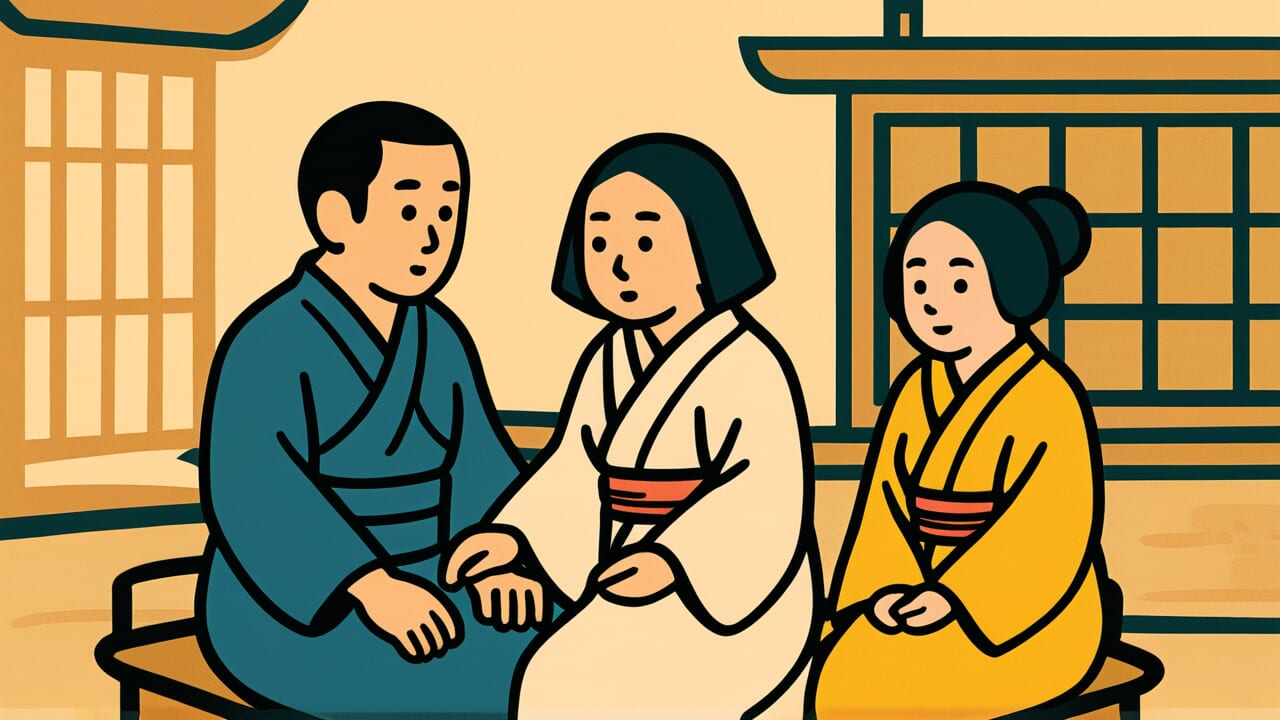How to Read “A man from the east and a woman from Kyoto”
Azuma otoko ni kyō onna
Meaning of “A man from the east and a woman from Kyoto”
This proverb expresses the idea that men from the eastern regions and women from Kyoto represent the ideal types. Men from the eastern regions, especially Edo and the Kanto area, were known for their strong character, honesty, and reliability.
Women from Kyoto, on the other hand, were said to possess elegance, refined speech, and sophisticated manners nurtured by the ancient capital’s culture.
People use this proverb when discussing ideal combinations of men and women or desirable temperaments. It evaluates not just physical beauty but overall charm, including personality, upbringing, and cultural background.
Today, the idea of regional differences in temperament has faded. However, this proverb celebrates how different virtues can harmonize beautifully. It praises the combination of strength with grace, and honesty with refinement.
Origin and Etymology
The exact origin of this proverb in historical texts is unclear. However, it was likely already widely used during the Edo period. At that time, Japan’s regions had very different climates and cultures.
People believed that those raised in different areas developed distinct temperaments and appearances.
Men from the eastern regions, especially the Kanto area, were considered to have a straightforward and masculine character. This came from the samurai culture deeply rooted in that land. Many also worked in physical labor, so they often had strong, sturdy builds.
Women from Kyoto were influenced by aristocratic and court culture dating back to the Heian period. They were praised for their graceful behavior and beautiful speech patterns.
This proverb likely emerged from these regional characteristics to express the ideal marriage match. The combination of a strong, reliable eastern man and an elegant, cultured Kyoto woman represented the best partnership.
Each partner’s strengths would complement the other. This proverb reflects the ideal image people of that time held, based on regional traits.
Interesting Facts
During the Edo period, eastern samurai sometimes married daughters of Kyoto court nobles. This had political significance, but people also welcomed it as an ideal combination. It united the samurai’s power with the nobility’s prestige.
Kyoto women’s speech, called “Kyō kotoba,” was treated as special. Its soft and elegant sound was admired throughout the Edo period.
Meanwhile, eastern men’s straightforward character was linked to Edo’s vibrant energy as an emerging city. It was valued as cutting-edge charm for the times.
Usage Examples
- They truly embody “a man from the east and a woman from Kyoto” – he’s a dependable husband and she’s a refined wife, the ideal couple
- The old saying “a man from the east and a woman from Kyoto” shows that men were expected to have strength while women were expected to have grace
Universal Wisdom
The proverb “a man from the east and a woman from Kyoto” reveals the aesthetics of harmony that humans instinctively seek. Why do people find ideals in combinations of those with different qualities?
It’s because humans unconsciously feel attracted to partners who possess what they lack.
Strength and grace, honesty and refinement, simplicity and elegance. These seem contrasting at first glance, but they actually complement each other. When people discover in others the elements they don’t have within themselves, they feel deep attraction.
When these different elements harmonize, they create new value that neither could produce alone.
This proverb has been passed down not simply because it describes regional characteristics. It contains an essential truth about human relationships. By recognizing differences and respecting each other’s strengths, we can build richer connections.
No one is perfect. That’s exactly why it’s meaningful when people with different virtues meet and support each other.
Our ancestors expressed this universal truth through the accessible form of specific regional traits. It continues to teach us across time about the value of diversity and the beauty of harmony.
When AI Hears This
Edo (Tokyo) and Kyoto are about 400 kilometers apart in a straight line. During the Edo period, this distance took about two weeks to walk one way.
Interestingly, biological research on “genetically optimal mate distance” shows a range that overlaps with exactly this geographical separation.
When blood relations are too close, harmful genes surface more easily. Conversely, when too distant, combinations of environmentally adapted genes break down. The middle point – “same climate zone but different gene pool” – is considered biologically ideal.
In the Japanese archipelago, Kanto and Kansai perfectly meet this condition. They belong to the same temperate zone, yet historically limited population movement preserved genetic differences.
Even more noteworthy is that this proverb doesn’t reverse the genders’ regions of origin. Anthropological research shows that in many societies, marriage patterns where women move are common.
This is because women have flexibility to adapt to new environments, while men maintain social capital rooted in their regions. This proverb may have unconsciously verbalized an optimal solution that achieves both genetic diversity and social stability simultaneously.
Lessons for Today
This proverb teaches us the importance of recognizing differences as valuable. Modern society requires us to respect each person’s individuality and background, rather than imposing uniform ideals.
Look around you. People with different upbringings and values are gathered together. If you can view those differences not as flaws but as possibilities for mutual complementation, your relationships will become much richer.
Strong people can be paired with gentle people. Logical people can be paired with emotionally rich people. Each can bring out the best in the other.
What matters is not envying what others have that you lack, but respecting them and learning from each other. At the same time, take pride in your own characteristics.
The strengths you possess are valuable to someone. Recognize diversity and aim for harmony. This ancient proverb continues to send us who live in modern times such a positive message.



Comments